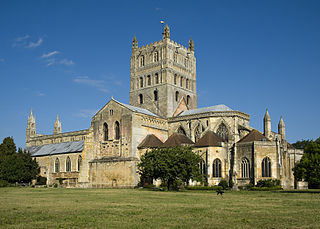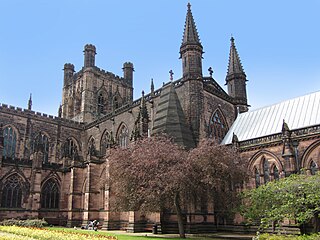
Gloucester is a cathedral city and the county town of Gloucestershire in the South West of England. Gloucester lies on the River Severn, between the Cotswolds to the east and the Forest of Dean to the west, 19 miles (31 km) east of Monmouth and 17 miles (27 km) east of the border with Wales. Including suburban areas, Gloucester has a population of around 132,000. It is a port, linked via the Gloucester and Sharpness Canal to the Severn Estuary.

The Abbey Church of St Mary the Virgin, Tewkesbury, commonly known as Tewkesbury Abbey, is located in the English county of Gloucestershire. A former Benedictine monastery, it is now a parish church. Considered one of the finest examples of Norman architecture in Britain, it has the largest Romanesque crossing tower in Europe.

Canterbury Cathedral in Canterbury, Kent, is one of the oldest and most famous Christian structures in England. It forms part of a World Heritage Site. It is the cathedral of the Archbishop of Canterbury, currently Justin Welby, leader of the Church of England and symbolic leader of the worldwide Anglican Communion. Its formal title is the Cathedral and Metropolitical Church of Christ at Canterbury.

Worcester Cathedral is an Anglican cathedral in Worcester, in Worcestershire, England, situated on a bank overlooking the River Severn. It is the seat of the Bishop of Worcester. Its official name is the Cathedral Church of Christ and the Blessed Mary the Virgin, of Worcester. The present cathedral church was built between 1084 and 1504, and represents every style of English architecture from Norman to Perpendicular Gothic. It is famous for its Norman crypt and unique chapter house, its unusual Transitional Gothic bays, its fine woodwork, and its "exquisite" central tower, which is of particularly fine proportions. The cathedral contains the tombs of King John, Prince Arthur and Prime Minister Stanley Baldwin.

Gloucester Cathedral, formally the Cathedral Church of St Peter and the Holy and Indivisible Trinity, in Gloucester, England, stands in the north of the city near the River Severn. It originated with the establishment of a minster, Gloucester Abbey, dedicated to Saint Peter and founded by Osric, King of the Hwicce, in around 679. The subsequent history of the church is complex; Osric's foundation came under the control of the Benedictine Order at the beginning of the 11th century and in around 1058, Ealdred, Bishop of Worcester, established a new abbey "a little further from the place where it had stood". The abbey appears not to have been an initial success, by 1072, the number of attendant monks had reduced to two. The present building was begun by Abbott Serlo in about 1089, following a major fire the previous year.

Bristol Cathedral, the Cathedral Church of the Holy and Undivided Trinity, is the Church of England cathedral in the city of Bristol, England. Founded in 1140 and consecrated in 1148, it was originally St Augustine's Abbey but after the Dissolution of the Monasteries it became in 1542 the seat of the newly created Bishop of Bristol and the cathedral of the new Diocese of Bristol. It is a Grade I listed building.

The King's School, Worcester is an English private day school refounded by Henry VIII in 1541. It occupies a site adjacent to Worcester Cathedral on the banks of the River Severn in the centre of the city of Worcester. It offers mixed-sex mainstream education that follows the UK National Curriculum to around 1,465 pupils aged 2 to 18. At age 11, approximately two thirds of pupils join the senior school from its two prep schools, King's Hawford and King's St Albans, while others come from maintained schools in the city of Worcester and the surrounding areas that include Malvern, Redditch, Kidderminster, Evesham and Pershore.

The region now known as Gloucestershire was originally inhabited by Brythonic peoples in the Iron Age and Roman periods. After the Romans left Britain in the early 5th century, the Brythons re-established control but the territorial divisions for the post-Roman period are uncertain. The city of Caerloyw was one centre and Cirencester may have continued as a tribal centre as well. The only reliably attested kingdom is the minor south-east Wales kingdom of Ergyng, which may have included a portion of the area. In the final quarter of the 6th century, the Saxons of Wessex began to establish control over the area.

Chester Cathedral is a Church of England cathedral and the mother church of the Diocese of Chester. It is located in the city of Chester, Cheshire, England. The cathedral, formerly the abbey church of a Benedictine monastery dedicated to Saint Werburgh, is dedicated to Christ and the Blessed Virgin Mary. Since 1541, it has been the seat of the Bishop of Chester.

Great Malvern Priory in Malvern, Worcestershire, England, was a Benedictine monastery and is now an Anglican parish church. In 1949 it was designated a Grade I listed building. It is a dominant building in the Great Malvern Conservation area. It has the largest display of 15th-century stained glass in England, as well as carved miserichords from the 15th and 16th century and the largest collection of medieval floor and wall tiles. In 1860 major restoration work was carried out by Sir George Gilbert Scott. It is also the venue for concerts and civic services.

Carlisle Cathedral is a Grade I listed Anglican cathedral in the city of Carlisle, Cumbria, England. It was founded as an Augustinian priory and became a cathedral in 1133. It is also the seat of the Bishop of Carlisle.

Prinknash Abbey is a Roman Catholic monastery in the Vale of Gloucester in the Diocese of Clifton, near the village of Cranham. It belongs to the English Province of the Subiaco Cassinese Congregation, which is itself part of the worldwide Benedictine Confederation. It is noted for its manufacturing of incense.

Christ Church Cathedral School is an independent preparatory school for boys in Oxford, England. It is one of three choral foundation schools in the city and educates choristers of Christ Church Cathedral, and the Chapels of Worcester College and Pembroke College. It is a member of the IAPS and the Choir Schools Association.

St Oswald's Priory was founded by Æthelflæd, daughter of Alfred the Great, and her husband Æthelred, ealdorman of Mercia, in the late 880s or the 890s. It appears to have been an exact copy of the Old Minster, Winchester It is a Grade I listed building.
Serlo was a medieval abbot of Gloucester Abbey.
Serlo was a medieval abbot of Cirencester Abbey in England as well as Dean of Salisbury.

Exeter Cathedral School (ECS) is a 3–13 mixed, Church of England, private day and boarding choir and preparatory school in Exeter, Devon, England. It has been closely associated with Exeter Cathedral since it was first recorded as existing in the 12th century.



















